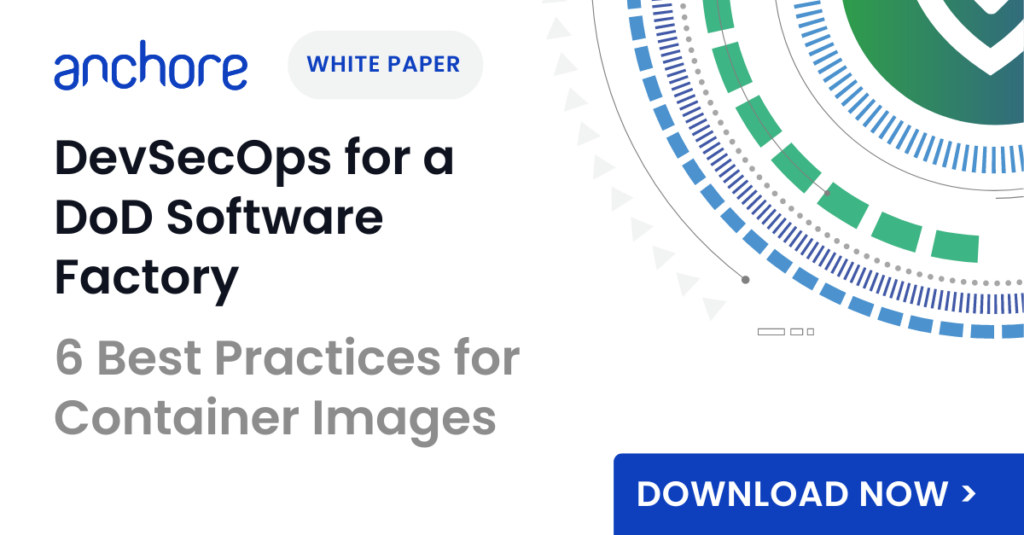Anchore’s Vice President of Security, Josh Bressers recently did an interview with Fed Gov Today about the role of automation in DevSecOps and how it is impacting the US federal government. We’ve condensed the highlights of the interview into a snackable blog post below.
Automation is the foundation of DevSecOps
Automation isn’t just a buzzword but is actually the foundation of DevSecOps. It is what gives meaning to marketing taglines like “shift left”. The point of DevSecOps is to create automated workflows that provide feedback to software developers as they are writing the application. This unwinds the previous practice of artificially grouping all of the “compliance” or “security” tasks into large blocks at the end of the development process. The challenge with this pattern is that it delays feedback and design decisions are made that become difficult to undo after development has completed. By inverting the narrative and automating feedback as design decisions are made, developers are able to prevent compliance or security issues before they become deeply embedded into the software.
DoD Software Factories are leading the way in DevSecOps adoption
The US Department of Defense (DoD) is at the forefront of implementing DevSecOps through their DoD software factory model. The US Navy’s Black Pearl and the Air Force’s Platform One are perfect examples of this program. These organizations are leveraging automation to streamline compliance work. Instead of relying on manual documentation ahead of Authority to Operate (ATO) reviews, automated workflows built directly into the software development pipeline provide direct feedback to developers. This approach has proven highly effective, Bressers emphasizes this in his interview:
It’s obvious why the DoD software factory model is catching on. It’s because they work. It’s not just talk, it’s actually working. There’s many organizations that have been talking about DevSecOps for a long time. There’s a difference between talking and doing. Software factories are doing and it’s amazing.
—Josh Bressers, VP of Security, Anchore
Benefits of compliance automation
By giving compliance the same treatment as security (i.e., automate all the things), tasks that once took weeks or even months, can now be completed in minutes or hours. This dramatic reduction in time-to-compliance not only accelerates development cycles but also allows teams to focus on collaboration and solution delivery rather than getting bogged down in procedural details. The result is a “shift left” approach that extends beyond security to compliance as well. When compliance is integrated early in the development process the benefits cascade down the entire development waterfall.
Compliance automation is shifting the policy checks left into the software development process. What this means is that once your application is finished; instead of the compliance taking weeks or months, we’re talking hours or minutes.
—Josh Bressers, VP of Security, Anchore
Areas for improvement
While automation is crucial, there are still several areas for improvement in DevSecOps environments. Key focus areas include ensuring developers fully understand the automated processes, improving communication between team members and agencies, and striking the right balance between automation and human oversight. Bressers emphasizes the importance of letting “people do people things” while leveraging computers for tasks they excel at. This approach fosters genuine collaboration and allows teams to focus on meaningful work rather than simply checking boxes to meet compliance requirements.
Standardizing communication workflows with integrated developer tools
Software development pipelines are primarily platforms to coordinate the work of distributed teams of developers. They act like old-fashioned switchboard operators that connect one member of the development team to the next as they hand-off work in the development production line. Leveraging developer tooling like GitLab or GitHub standardizes communication workflows. These platforms provide mechanisms for different team members to interact across various stages of the development pipeline. Teams can easily file and track issues, automatically pass or fail tests (e.g., compliance tests), and maintain a searchable record of discussions. This approach facilitates better understanding between developers and those identifying issues, leading to more efficient problem-solving and collaboration.
The government getting ahead of the private sector: an unexpected narrative inversion
In a surprising turn of events, Bressers points out that government agencies are now leading the way in DevSecOps implementation by integrating automated compliance. Historically often seen as technologically behind, federal agencies, through the DoD software factory model, are setting new standards that are likely to influence the private sector. As these practices become more widespread, contractors and private companies working with the government will need to adapt to these new requirements. This shift is evident in recent initiatives like the SSDF attestation questionnaire and White House Executive Order (EO) 14028. These initiatives are setting new expectations for federal contractors, signaling a broader move towards making compliance a native pillar of DevSecOps.
This is one of the few instances in recent memory where the government is truly leading the way. Historically the government has often been the butt of jokes about being behind in technology but these DoD software factories are absolutely amazing. The next thing that we’re going to see is the compliance expectations that are being built into these DoD software factories will seep out into the private sector. The SSDF attestation and the White House Executive Order are only the beginning. Ironically my expectation is everyone is going to have to start paying attention to this, not just federal agencies.
—Josh Bressers, VP of Security, Anchore
Next Steps
If you’re interested to learn more about how to future-proof your software supply chain with compliance automation via the DoD software factory model, be sure to read our white paper.
If you’d like to hear the interview in full, be sure to watch it on Fed Gov Today’s Youtube channel.

